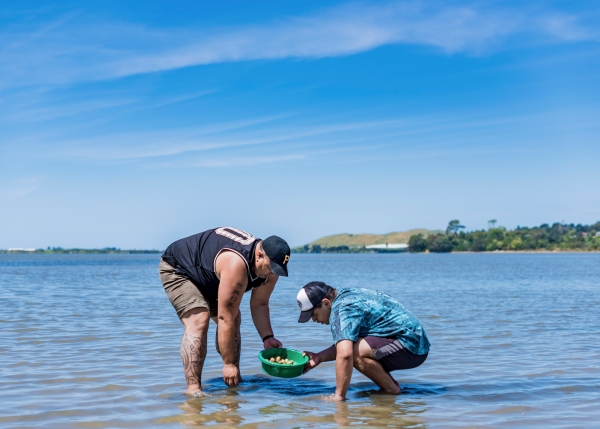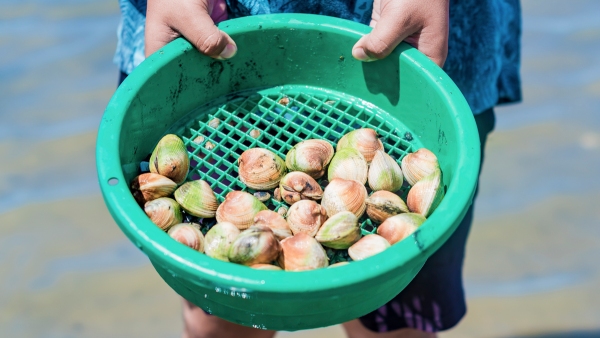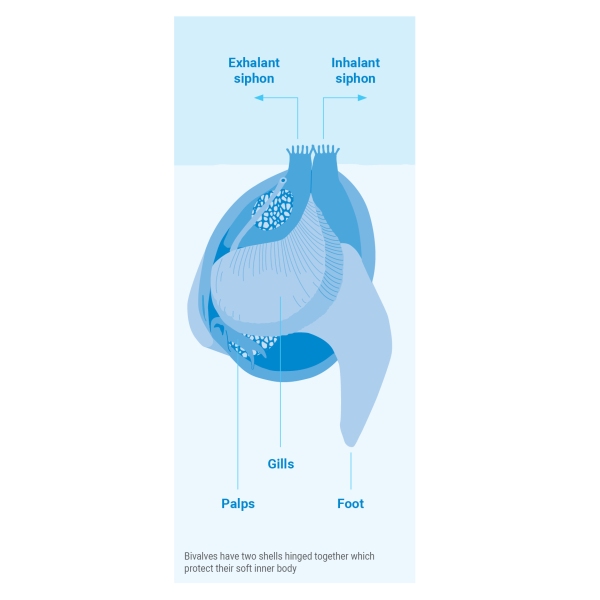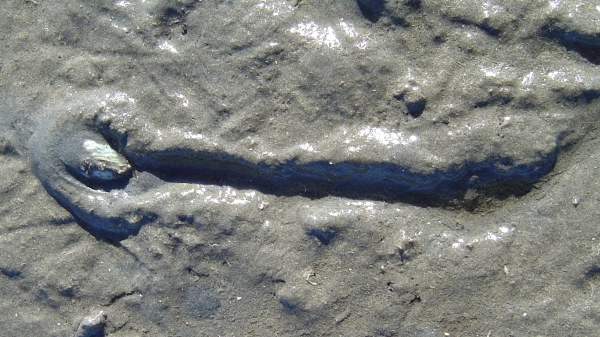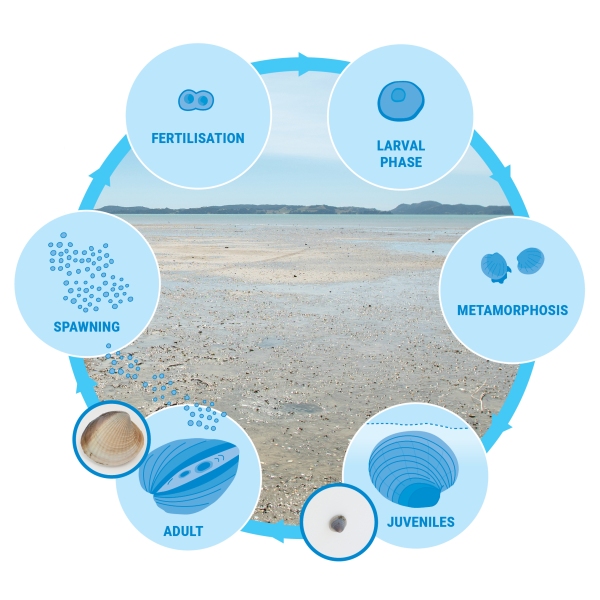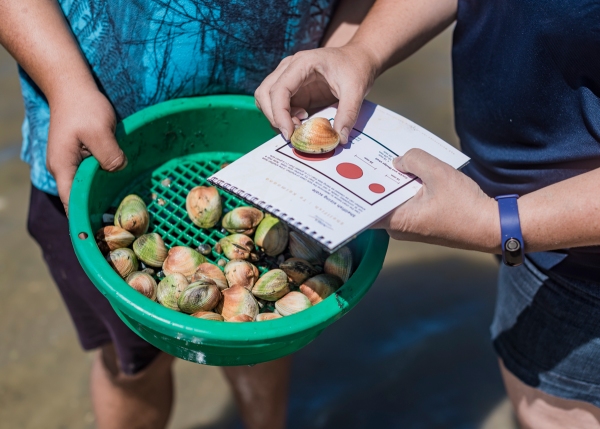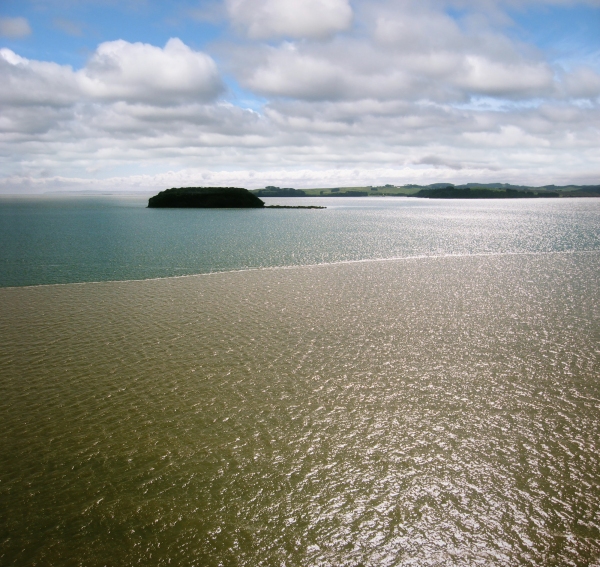Taonga species such as kanae (mullet), tuangi (cockles) and pātiki (flounder) are central to the identity and wellbeing of many Māori.
For generations these species have sustained communities and helped transfer customary practices and knowledge from one generation to the next.
However, many communities are reporting that both the abundance and size of these freshwater taonga are declining. Te Kūwaha, NIWA’s National Centre for Māori Environmental Research has been working with whānau, hapū and iwi for more than a decade to co-develop methods for the protection, restoration and economic development of these species.
What is tuangi and where can you find it?
Tuangi are clams which are endemic to Aotearoa.
Tuangi (Austrovenus stutchburyi) are commonly known as the New Zealand cockle or little neck clam, as well as hūwai, tuaki or huangi depending on iwi dialect.
They are one of the most common and widespread shellfish in Aotearoa with populations found in the North and South Island, Stewart Island, the Chatham Islands, and the Subantarctic islands. Tuangi are usually found buried just below the surface of sheltered intertidal mud and sand flats. Most tuangi will be found 2-4 cm beneath the surface.
They can be found closely packed together with more than 3,000 individual tuangi per square metre!
Why are tuangi important?
Tuangi are functionally important and can positively contribute to their ecosystem.
Water clarity Tuangi can filter up to 3 litres of water per hour! When tuangi are in high densities, this has a positive effect on water clarity.
Bioindicator Tuangi are sensitive to long term exposure of environmental stressors, including sediments and high levels of mud and copper contaminants, which can affect their behaviour and survival as well as decrease abundances.
Nutrient dynamics The filtering ability of tuangi means they can trap nutrients and sediments then cycle them through the ecosystem.
Food source Tuangi are an important food source for fish, crabs, and people.
Tuangi anatomy
The basic anatomy of tuangi includes:
Shell The hard-outer shell helps to provide protection from predation, physical damage, and drying out. The grooves on the shell also provide stability from the waves and shifting sand.
Siphons Each tuangi has two siphons – the inhalant siphon draws in seawater and the exhalant siphon expels it.
Gills The gills play an important role in filtering seawater to obtain oxygen, as well as capturing plant material and small microscopic animals.
Palps Large particles that are not ingested are redirected by the palps into the exhalant water stream.
Foot The tuangi uses it’s muscular foot to move and burrow into the sand.
Tuangi mobility
Tuangi can move up, down, and across the sand by digging and crawling with their strong muscular foot.
Tuangi are found just below the sediment surface, so that their short siphons can extend up and into the water column for feeding. They can move up to 1.5 m along the shore pertidal cycle by crawling.
This mobility is important as they often need to move closer to the surface when there are small increases in sediment around them, or if they become dislodged.
Juveniles vs. adults
Juveniles are more mobile than adults, with most adult tuangi remaining lower on the shore where food availability is greater.
Juveniles tend to settle slightly higher on the shore than the adult populations. As they grow bigger, these smaller tuangi will move lower down the shore, maximising food availability.
Life cycle
Tuangi are one of the most widespread shellfish found in tidal mud and sand flats in Aotearoa.
Spawning Adult tuangi are broadcast spawners, which means they release their sperm and eggs into the water column during warmer periods, usually spring and summer. The eggs may float in the sea for some time before they are fertilised and develop into tiny larvae called veligers.
Larval phase During the larval phase, tuangi drift and feed on phytoplankton (microscopic plant material) in the water column. Eventually, the larvae will transform (undergo metamorphosis) and settle into the sand.
Juveniles Once transformed into a juvenile, tuangi will burrow beneath the surface of the sand. Juveniles can grow up to 1 cm per year for the first two years, then the growth rate begins to slow as they mature.
Adult tuangi Most tuangi will grow up to 50 mm in length and may live up to 25 years. Adult tuangi mature and begin spawning when their shell length reaches approximately 18 mm, which usually takes 2-3 years, depending on location and conditions. Typically, the larger the female, the more eggs she can produce.
What do tuangi eat?
Tuangi are filter (suspension) feeders, which means they obtain all their food by straining it from the water. They mainly feed on phytoplankton (microscopic plants).
Using the inhalant siphon, tuangi inhale water to their gills where food and inedible matter is sorted. The inedible matter is discarded as pseudofaeces or redirected to the exhalant water stream and expelled through the exhalant siphon.
Due to their strong filtering abilities, tuangi can also accumulate bacteria and contaminants (e.g., various metals) in their flesh. Depending on the type of contaminant and the amount accumulated, this may pose a human health risk to those consuming the tuangi. Therefore, it is important to collect tuangi from areas with healthy water sources and to avoid harvesting for up to three days after rain events to minimise these risks.
What affects tuangi growth?
There are several factors which can affect the growth of tuangi including:
Age The growth rate of tuangi tends to slow as they get older.
Food availability The more food (like plankton) that is available for tuangi, the higher the growth rate.
Position on the beach The growth rate increases the further you move seaward. This is because the longer tuangi are submerged under water, the longer food is available, and therefore the faster they can grow.
Seasons Tuangi growth tends to be most rapid over the spring and summer periods.
Environmental conditions Including temperature and salinity can affect the growth rate.
Most of the factors which can affect the growth rate of tuangi can be attributed back to the age of tuangi or food availability.
What are the threats for tuangi?
Across Aotearoa, tuangi are exposed to a range of threats which could impact their population, including:
Climate change Changes in sea temperature and pH can affect survival and shell formation.
Predators Shorebirds such as oystercatchers, marine life like stingrays, paddle crabs, flounders, and starfish prey on tuangi.
Sediment input Significant increases in sediment inputs to tuangi habitats, particularly from run off from land or erosion during storms, can lead to a loss of suitable habitat and may even smother tuangi. It can also elevate suspended sediment concentrations, making filter feeding more difficult.
Over harvesting Human harvesting activities can also negatively impact tuangi populations.
It is important to monitor the tuangi population over time as this could help to identify or minimise the impact of these threats.
How can we help tuangi?
Tuangi are an important taonga species across Aotearoa. Some ways we can help our tuangi populations include:
- Protect and restore tuangi habitat
- Ensure estuaries are healthy, with good water and sediment quality
- Get involved in tuangi monitoring surveys and programmes
- Following harvest regulations in place in your area and not taking more than you need
- The daily bag limit is typically 150 per person, except for Auckland, Coromandel and other rāhui areas where the daily limit is lower or restricted. Please check your local regulations before harvesting.

